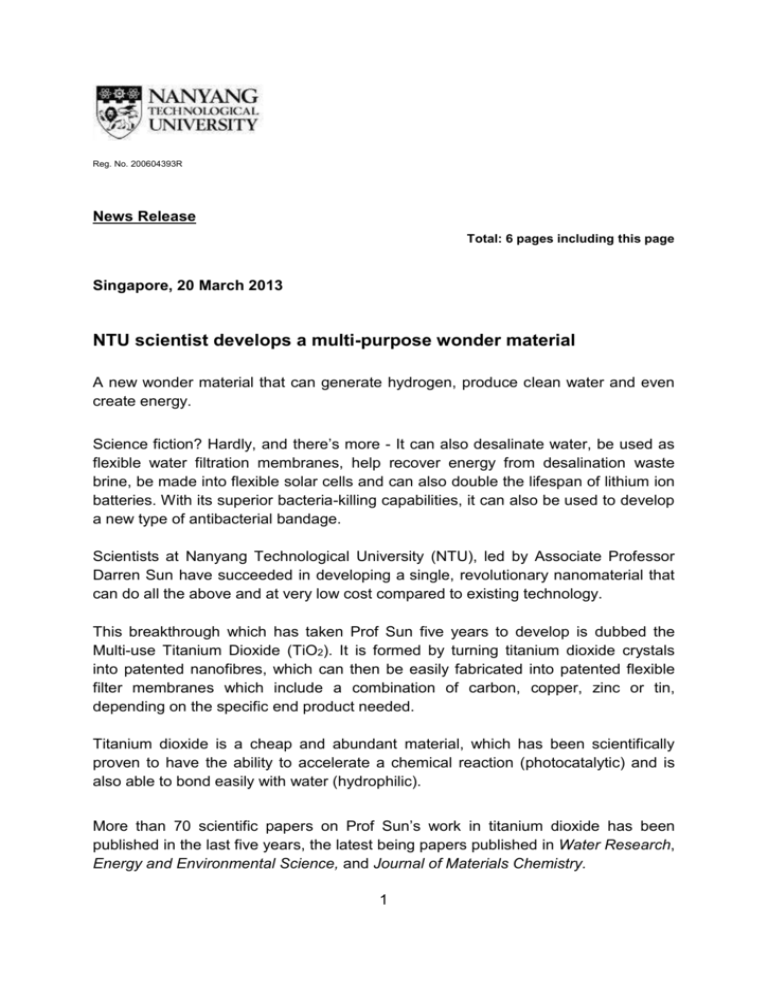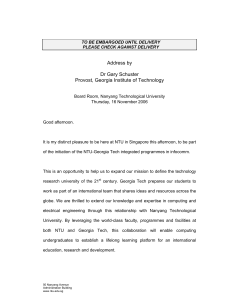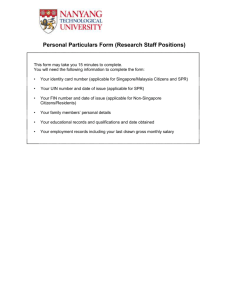here
advertisement

Reg. No. 200604393R News Release Total: 6 pages including this page Singapore, 20 March 2013 NTU scientist develops a multi-purpose wonder material A new wonder material that can generate hydrogen, produce clean water and even create energy. Science fiction? Hardly, and there’s more - It can also desalinate water, be used as flexible water filtration membranes, help recover energy from desalination waste brine, be made into flexible solar cells and can also double the lifespan of lithium ion batteries. With its superior bacteria-killing capabilities, it can also be used to develop a new type of antibacterial bandage. Scientists at Nanyang Technological University (NTU), led by Associate Professor Darren Sun have succeeded in developing a single, revolutionary nanomaterial that can do all the above and at very low cost compared to existing technology. This breakthrough which has taken Prof Sun five years to develop is dubbed the Multi-use Titanium Dioxide (TiO2). It is formed by turning titanium dioxide crystals into patented nanofibres, which can then be easily fabricated into patented flexible filter membranes which include a combination of carbon, copper, zinc or tin, depending on the specific end product needed. Titanium dioxide is a cheap and abundant material, which has been scientifically proven to have the ability to accelerate a chemical reaction (photocatalytic) and is also able to bond easily with water (hydrophilic). More than 70 scientific papers on Prof Sun’s work in titanium dioxide has been published in the last five years, the latest being papers published in Water Research, Energy and Environmental Science, and Journal of Materials Chemistry. 1 Prof Sun, 52, from NTU’s School of Civil and Environmental Engineering, said such a low-cost and easily produced nanomaterial is expected to have immense potential to help tackle ongoing global challenges in energy and environmental issues. With the world’s population expected to hit 8.3 billion by 2030, there will be a massive increase in the global demand for energy and food by 50 per cent and 30 per cent for drinking water (Population Institute report, titled 2030: The “Perfect Storm” Scenario). “While there is no single silver bullet to solving two of the world’s biggest challenges: cheap renewable energy and an abundant supply of clean water; our single multiuse membrane comes close, with its titanium dioxide nanoparticles being a key catalyst in discovering such solutions,” Prof Sun said. “With our unique nanomaterial, we hope to be able to help convert today’s waste into tomorrow’s resources, such as clean water and energy.” Prof Sun’s multi-use titanium dioxide can: 1. concurrently produce both hydrogen and clean water when exposed to sunlight 2. be made into a low-cost flexible filtration membrane that is anti-fouling 3. desalinate water as a high flux forward osmosis membrane 4. recover energy from waste desalination brine and wastewater 5. be made into a low-cost flexible solar cell to generate electricity 6. doubles battery life when used as anode in lithium ion battery 7. kill harmful microbial, leading to new antibacterial bandages How the wonder material was found Prof Sun had initially used titanium dioxide with iron oxide to make anti-bacterial water filtration membranes to solve biofouling - bacterial growth which clogs up the pores of membranes, obstructing water flow. While developing the membrane, Prof Sun’s team also discovered that it could act as a photocatalyst, turning wastewater into hydrogen and oxygen under sunlight while still producing clean water. Such a water-splitting effect is usually caused by Platinum, a precious metal that is both expensive and rare. “With such a discovery, it is possible to concurrently treat wastewater and yet have a much cheaper option of storing solar energy in the form of hydrogen so that it can be 2 available any time, day or night, regardless of whether the sun is shining or not, which makes it truly a source of clean fuel,” said Prof Sun. “As of now, we are achieving a very high efficiency of about three times more than if we had used platinum, but at a much lower cost, allowing for cheap hydrogen production. In addition, we can concurrently produce clean water for close-to-zero energy cost, which may change our current water reclamation system over the world for future liveable cities.” Producing hydrogen and clean water This discovery, which was published recently in the academic journal, Water Research, showed that a small amount of nanomaterial (0.5 grams of titanium dioxide nanofibres treated with copper oxide), can generate 1.53 millilitre of hydrogen in an hour when immersed in one litre of wastewater. This amount of hydrogen produced is three times more than when Platinum is used in the same situation. Depending on the type of wastewater, the amount of hydrogen generated can be as much as 200 millilitres in an hour. Also to increase hydrogen production, more nanomaterial can be used in larger amounts of wastewater. Producing low-cost flexible forward osmosis membranes Not only can titanium dioxide particles help split water, it can also make water filter membranes hydrophilic - allowing water to flow through it easily, while rejecting foreign contaminants, including those of salt, making it perfect for desalinating water using forward osmosis. Thus a new super high flux (flow rate) forward osmosis membrane is developed. This discovery was published recently in last month’s journal of Energy and Environmental Science. This is the first such report of TiO2 nanofibres and particles used in forward osmosis membrane system for clean water production and energy generation. Producing new antibacterial bandages With its anti-microbial properties and low cost, the membrane can also be used to make breathable anti-bacterial bandages, which would not only prevent infections and tackle infection at open wounds, but also promote healing by allowing oxygen to permeate through the plaster. 3 The membrane’s material properties are also similar to polymers used to make plastic bandages currently sold on the market. Producing low-cost flexible solar cells Prof Sun’s research projects have shown out that when treated with other materials or made into another form such as crystals, titanium dioxide can have other uses, such as in solar cells. By making a black titanium dioxide polycrystalline sheet, Prof Sun’s team was able to make a flexible solar-cell which can generate electricity from the sun’s rays. Producing longer lasting lithium ion batteries Concurrently, Prof Sun has another team working on developing the black titanium dioxide nanomaterial to be used in Lithium ion batteries commonly used in electronic devices. Preliminary results from thin coin-like lithium ion batteries, have shown that when titanium dioxide sphere-like nanoparticles modified with carbon are used as the anode (negative pole), it can double the capacity of the battery. This gives such batteries a much longer lifespan before it is fully drained. The results were featured prominently in a highly respected Journal of Materials Chemistry on its cover page last year. Next step – commercialisation Prof Sun and his team of 20, which includes 6 undergraduates, 10 PhD students and 4 researchers, are now working to further develop the material while concurrently spinning off a start-up company to commercialise the product. They are also looking to collaborate with commercial partners to speed up the commercialisation process. ***END*** 4 Media contact: Lester Kok Assistant Manager Corporate Communications Office Nanyang Technological University Tel: 6790 6804; Mobile: 9741 5593 Email: lesterkok@ntu.edu.sg About Nanyang Technological University A research-intensive public university, Nanyang Technological University (NTU) has 33,500 undergraduate and postgraduate students in the colleges of Engineering, Business, Science, and Humanities, Arts, & Social Sciences. It has a new medical school, the Lee Kong Chian School of Medicine, set up jointly with Imperial College London. NTU is also home to world-class autonomous institutes – the National Institute of Education, S Rajaratnam School of International Studies, Earth Observatory of Singapore, and Singapore Centre on Environmental Life Sciences Engineering – and various leading research centres such as the Nanyang Environment & Water Research Institute (NEWRI), Energy Research Institute @ NTU (ERI@N) and the Institute on Asian Consumer Insight (ACI). A fast-growing university with an international outlook, NTU is putting its global stamp on Five Peaks of Excellence: Sustainable Earth, Future Healthcare, New Media, New Silk Road, and Innovation Asia. Besides the main Yunnan Garden campus, NTU also has a satellite campus in Singapore’s science and tech hub, one-north, and a third campus in Novena, Singapore’s medical district. For more information, visit www.ntu.edu.sg 5 Associate Professor Darren Sun School of Civil and Environmental Engineering, NTU Associate Professor Darren Sun is renowned for his work in developing nanotechnology for clean water and energy production. He was recently awarded the President Award from Tokyo University of Science, Japan, for his titanium dioxide technology for pollutants removal, water reclamation, and generating hydrogen from water last week. At last September’s International Water Association (IWA) Congress in Korea, Prof Sun was elected IWA Fellow and has been invited as a Shimizu Visiting Professor at Environmental Engineering and Science Program, Stanford University, USA. For his nanotechnology research, Prof Sun have won many competitive research grants, worth more than $21 million from agencies such as the Environment & Water Industry Development Council, Clean Energy Program of National Research Fundation (NRF), Ministry of Education, PUB, the national water agency of Singapore, Prime Minister’s Office of Singapore via an initiative called The Enterprise Challenge and the Maritime and Port Authority of Singapore. His ongoing projects include producing methane fuel from CO2 and water via a special HOT-DNA membrane, refining bunker oil from waste oil sludge, nanoabsorbents to treat oil spills, nano-fibre membrane for water treatment and various next generation solar cells for commercial applications. ### 6




